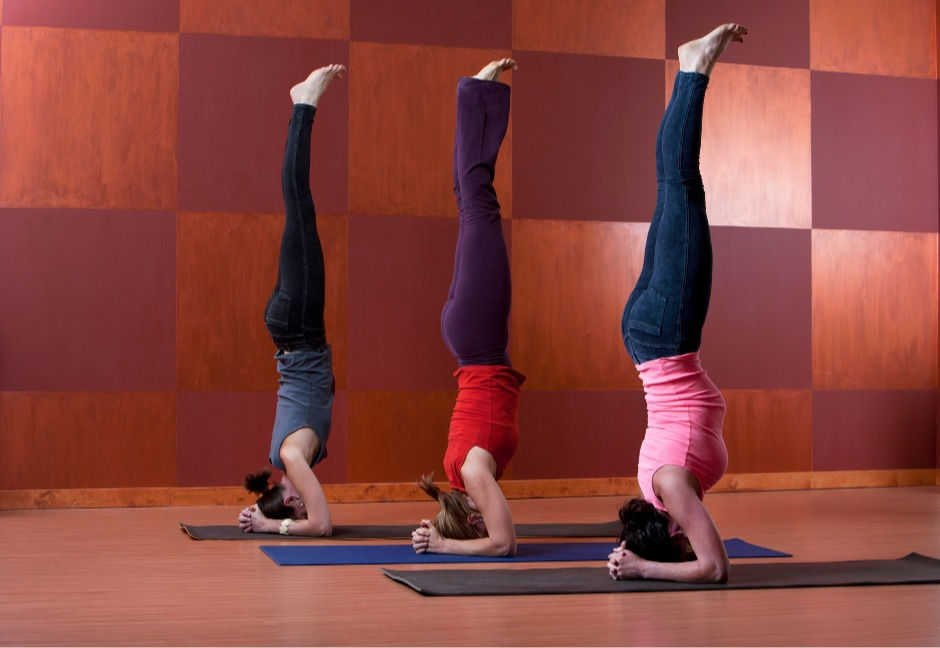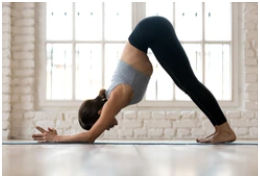Yoga is an ancient practice offering numerous benefits for the mind and body. The headstand is often considered challenging yet highly rewarding among advanced yoga poses. In this article, we will guide you through the step-by-step process of performing a headstand in yoga. We'll cover everything from preparatory poses and setting up to getting into the headstand, remaining in the pose, and safely exiting it.
Additionally, we'll discuss the significance of the headstand in yoga, provide safety tips, outline its benefits, identify common mistakes to avoid, and answer frequently asked questions.

In this Post:
Sirsasana, commonly known as the headstand, is an inverted yoga pose that involves supporting the body with the head and forearms while lifting the legs overhead. It's a challenging pose that requires strength, balance, and focus and offers many physical and mental benefits. However, beginners should approach it with care and seek the guidance of a qualified yoga instructor when practicing.
Importance of the Headstand Pose in Yoga
The headstand is the most essential yoga pose because of its numerous advantages. It enhances blood flow to the brain, enhancing mental clarity, focus, and concentration. The headstand also reinforces the shoulders, arms, core, and upper back, improving overall upper body strength. It also activates the lymphatic system, which can help eliminate toxins from the body and boost the immune system. Furthermore, the headstand can soothe the nervous system, decrease stress and anxiety, and enhance posture.
Conquering the Headstand Pose in Yoga
Step 1: Preparatory Poses
To perform a headstand safely, it's essential to warm up your body and prepare it for the inversion. Several preparatory poses can help you build the necessary strength and flexibility, such as:
Dolphin Pose

Start in a downward-facing dog pose with your forearms resting on the mat, shoulder-width apart. Press your forearms and palms firmly into the mat, and engage your core as you lift your hips towards the ceiling. Hold this pose for a few breaths, keeping your head and neck relaxed.
Downward Facing Dog Pose

Start in a tabletop position with your hands shoulder-width apart, fingers spread wide, and toes tucked under. Press into your palms and lift your hips towards the ceiling, coming into an inverted V shape. Engage your core, lengthen your spine, and relax your head and neck. Hold this pose briefly, maintaining a straight line from your hands to your hips.
Step 2: Setting Up
Proper alignment and setup are crucial for a safe and effective headstand. Follow these steps to set up for a headstand:
Find a clear, open space with a non-slip surface, such as a yoga mat, to practice your headstand.
Kneel on the floor with your knees hip-width apart and place your forearms on the mat in front of you, with your elbows directly under your shoulders.
Interlace your fingers and place the crown of your head on the mat, creating a tripod base with your forearms and head.
Ensure that your head is firmly supported and your neck is neutral, avoiding strain.
Tuck your toes under and lift your hips towards the ceiling, coming into a dolphin pose with your legs extended and your heels lifted off the mat.
Walk your feet towards your elbows, as close as you can comfortably manage while keeping your shoulders relaxed away from your ears.
Step 3: Getting into Headstand
Once you are set up in the dolphin pose, you can start to lift into the headstand:
Engage your core and shift your weight, bringing your shoulders over your wrists.
Begin to lift one leg off the mat, keeping the other leg grounded for support.
Slowly kick the lifted leg towards the ceiling, using your core strength to control the movement.
As you kick, focus on the mat between your hands and avoid sudden or jerky movements.
Aim to bring both legs up towards the ceiling, keeping them straight and engaged and finding your balance in the headstand.
Step 4: Staying in Headstand
Once you are in the headstand, it's important to maintain proper alignment and stability to stay in the pose:
Engage your core and leg muscles to keep your legs straight and your toes pointed toward the ceiling.
Relax your neck and shoulders, avoiding any tension or strain.
Breathe deeply and evenly, focusing on steady inhales and exhales to help calm the mind and stabilize the pose.
You can experiment with different leg variations, such as bringing your legs into a pike position or extending them into a wide straddle.
Avoid staying in the headstand for too long, especially if you are a beginner. Start with short holds, gradually increasing the duration as you gain strength and stability.
Step 5: Coming Out of Headstand
When you are ready to come out of the headstand, it's essential to exit the pose with control and awareness:
Lower your legs slowly and with control, avoiding any sudden movements.
If you lose balance, gently roll out of the pose to the side, avoiding any impact on your neck or head.
Use the support of the wall if needed by walking your feet down the wall as you lower your legs.
Return to the dolphin pose, then lower your knees to the mat, resting in the child's pose to release tension in your neck and shoulders.
Head Stand Yoga Pose - How To Do a Headstand for Beginners
Safety Tips to Keep in Mind
The headstand is an advanced pose that requires caution and proper alignment to avoid any risks of injury. Here are some safety tips to keep in mind:

Practice under the guidance of a qualified yoga instructor, especially if you are a beginner or have any neck or shoulder issues.
Avoid practicing the headstand if you have high blood pressure, neck or head injuries, or are pregnant.
Warm up your body with preparatory poses and listen to your body's signals during the practice.
Use a non-slip surface and avoid practicing on a hard or uneven surface.
Do not force or rush into the headstand, and avoid any sudden movements or jerks to protect your neck and head. Remember that safety should always be your top priority in your yoga practice.
Tips for a Successful Headstand Practice
Here are some additional tips to make your headstand practice safe and effective:
Start with preparatory poses: Practice poses like downward dog, dolphin pose, and forearm plank to build strength and stability in your shoulders, core, and upper body before attempting the headstand. |
Use a wall for support: Practicing headstand against a wall can provide support and help you build confidence in the pose. Place your head and forearms about a foot away from the wall, and use it to assist with balance and alignment. |
Engage your core: Strong core engagement is crucial in headstand. Keep your core muscles activated throughout the practice to maintain stability and control. |
Take breaks: If you feel fatigued or lose balance, it's important to take breaks and come out of the pose. Pushing yourself beyond your limits can lead to injury. |
Practice patience and consistency: Headstand requires time and practice to master. Be patient with yourself and practice regularly to improve your strength, stability, and balance. |
The headstand is a challenging yet rewarding yoga pose that offers a wide range of physical, mental, and emotional benefits. By following proper alignment, engaging your core, and practicing with mindfulness, you can safely and effectively incorporate headstand into your yoga practice. Remember to always prioritize safety, listen to your body, and practice under the guidance of a qualified yoga instructor, especially if you are a beginner. So, take your time, be patient, and enjoy the journey of mastering this powerful pose.
FAQs (Frequently Asked Questions)
Is the headstand suitable for beginners? Headstand is an advanced pose that requires significant upper body strength, core stability, and proper alignment. It is not recommended for beginners, and it's essential to practice under the guidance of a qualified yoga instructor to avoid risks of injury.
How long should I hold the headstand? As a beginner, starting with short holds of 10-15 seconds is recommended, and gradually increasing the duration as you gain strength and stability. Avoid staying in the pose for too long to prevent strain on the neck and shoulders.
Can I practice a headstand if I have neck or shoulder issues? If you have neck or shoulder issues, it's best to avoid practicing headstands without consulting a qualified healthcare professional. The pose puts significant pressure on the neck and shoulders, and it's crucial to ensure that you are physically ready for the pose before attempting it, especially if you have any pre-existing conditions.
What are some preparatory poses for headstands? Some primary headstand poses include downward dog, dolphin pose, forearm plank, and shoulder stand. These poses can help you build strength and stability in your shoulders, core, and upper body, preparing you for the headstand practice.
Can I practice a headstand during menstruation? It's generally not recommended to practice a headstand during menstruation due to the increased pressure on the pelvic area and the inversion of the pose. It's best to listen to your body and avoid uncomfortable poses during your menstrual cycle.
Can I practice a headstand with high blood pressure or other medical conditions? Suppose you have any medical conditions, including high blood pressure or other health concerns. In that case, it's crucial to consult a qualified healthcare professional before attempting a headstand or different inversions. Inversions can affect blood pressure and may not be suitable for everyone.
Can I practice a headstand without a qualified yoga instructor? A headstand is an advanced pose that requires proper alignment, technique, and safety precautions. It's highly recommended to practice headstand under the guidance of a qualified yoga instructor to ensure good form, reduce the risk of injury, and receive personalized guidance based on your individual needs and abilities.
Are there any variations of headstands for beginners? Yes, variations of headstands are suitable for beginners, such as a supported headstand using a wall or a yoga block for additional support. These variations can help beginners build strength, stability, and confidence in their headstand practice.


































Comments